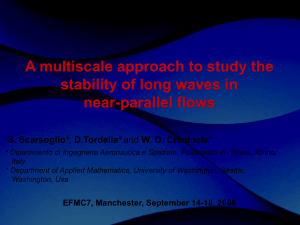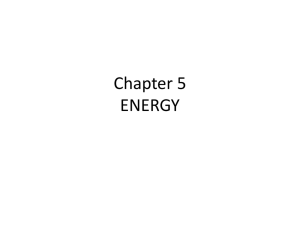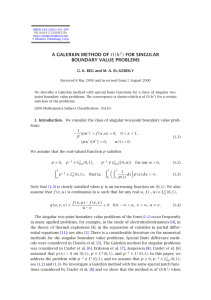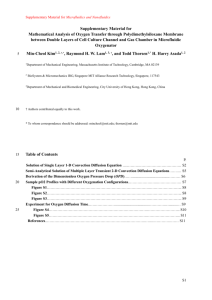A Multiscale Approach to the Boltzmann-BGK Equation Alan Medinger , Rachel Nevin
advertisement
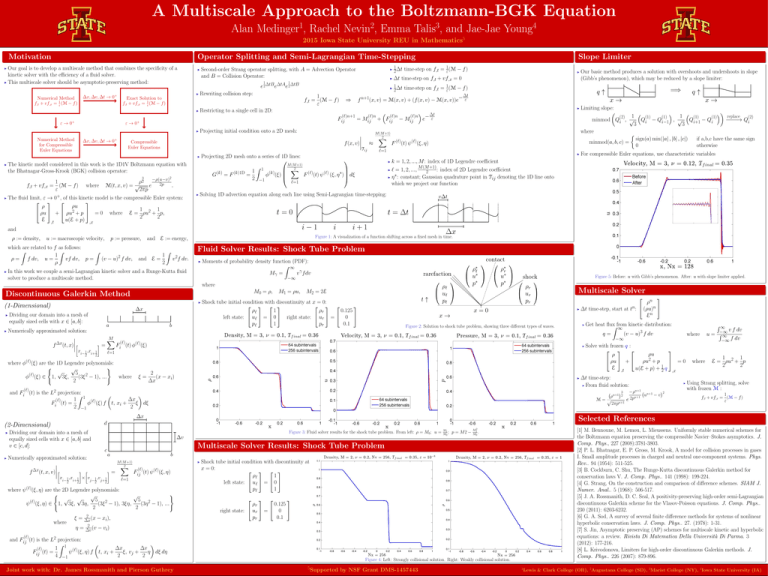
A Multiscale Approach to the Boltzmann-BGK Equation 1 2 3 Alan Medinger , Rachel Nevin , Emma Talis , and Jae-Jae Young 4 2015 Iowa State University REU in Mathematics5 Operator Splitting and Semi-Lagrangian Time-Stepping Motivation Our goal is to develop a multiscale method that combines the specificity of a kinetic solver with the efficiency of a fluid solver. I This multiscale solver should be asymptotic-preserving method: I ∆x, ∆v, ∆t → 0 Numerical Method f,t + vf,x = 1ε (M − f ) 1 ∆tB ∆tA 1 ∆tB e e2 e2 I + Second-order Strang operator splitting, with A = Advection Operator and B = Collision Operator: I Rewriting collision step: I I 1 ∆t time-step on f = 1 (M − f ) ,t ε 2 I ∆t time-step on f,t + vf,x = 0 Restricting to a single cell in 2D: ⇒ Numerical Method for Compressible Euler Equations ∆x, ∆v, ∆t → 0+ Projecting initial condition onto a 2D mesh: f (x, v) Compressible Euler Equations The kinetic model considered in this work is the 1D1V Boltzmann equation with the Bhatnagar-Gross-Krook (BGK) collision operator: 1 f,t + vf,x = (M − f ) ε 3 ρ2 M(t, x, v) = √ where 2πp −ρ(u−v)2 e 2p . I where 1 2 1 E = ρu + p, 2 2 k = 1, 2, ..., M : index of 1D Legendre coefficient M (M +1) I ` = 1, 2, ..., : index of 2D Legendre coefficient 2 ∗ I η : constant; Gaussian quadrature point in Tij denoting the 1D line onto which we project our function v∆t t = ∆t u := macroscopic velocity, p := pressure, and E := energy, 1 and E = 2 i i+1 ∆x Figure 1: A visualization of a function shifting across a fixed mesh in time. Fluid Solver Results: Shock Tube Problem Z v 2f dv. I In this work we couple a semi-Lagrangian kinetic solver and a Runge-Kutta fluid solver to produce a multiscale method. Moments of probability density function (PDF): Z ∞ Mγ = v γ f dv rarefaction ρ` u` t↑ p` −∞ where M0 = ρ, Discontinuous Galerkin Method I (1-Dimensional) I ∆x Dividing our domain into a mesh of equally sized cells with x ∈ [a, b]: Numerically approximated solution: ∆x f (t, x) x 1 ,x 1 i− 2 i+ 2 a b M1 = ρu, M2 = 2E Shock tube initial condition with discontinuity at x = 0: ρr 0.125 1 ρ` left state: u` = 0 right state: ur = 0 p` 0.1 1 pr contact ∗ ∗ ρ` ρr u∗ u∗ shock p∗ p∗ ρr ur pr I I 2 ξ= (x − xi) ∆x I Numerically approximated solution: ∆x f (t, x, v) p = M2 − where ∆t time-step: I From fluid solution: 2 −ρn+1 n+1 u −v n+1 e 2p I where 1 2 1 E = ρu + p 2 2 Using Strang splitting, solve with frozen M : 1 f,t + vf,x = (M − f ) ε [1] M. Bennoune, M. Lemou, L. Mieussens. Uniformly stable numerical schemes for the Boltzmann equation preserving the compressible Navier–Stokes asymptotics. J. Comp. Phys., 227 (2008):3781-3803. [2] P. L. Bhatnagar, E. P. Gross, M. Krook, A model for collision processes in gases I. Small amplitude processes in charged and neutral one-component systems. Phys. Rev.. 94 (1954): 511-525. [3] B. Cockburn, C. Shu, The Runge-Kutta discontinuous Galerkin method for conservation laws V. J. Comp. Phys.. 141 (1998): 199-224. [4] G. Strang, On the construction and comparison of difference schemes. SIAM J. Numer. Anal.. 5 (1968): 506-517. [5] J. A. Rossmanith, D. C. Seal, A positivity-preserving high-order semi-Lagrangian discontinuous Galerkin scheme for the Vlasov-Poisson equations. J. Comp. Phys.. 230 (2011): 6203-6232. [6] G. A. Sod, A survey of several finite difference methods for systems of nonlinear hyperbolic conservation laws. J. Comp. Phys.. 27. (1978): 1-31. [7] S. Jin, Asymptotic preserving (AP) schemes for multiscale kinetic and hyperbolic equations: a review. Rivista Di Matematica Della Università Di Parma. 3 (2012): 177-216. [8] L. Krivodonova, Limiters for high-order discontinuous Galerkin methods. J. Comp. Phys.. 226 (2007): 879-896. M12 M0 . b I (`) Fij (t) ψ (`)(ξ, η) `=1 where ψ (`)(ξ, η) are the 2D Legendre polynomials: ( ) √ √ √ √ 5 2 5 2 (`) ψ (ξ, η) ∈ 1, 3ξ, 3η, (3ξ − 1), 3ξη, (3η − 1), ... 2 2 where M1 M0 ; Multiscale Solver Results: Shock Tube Problem x 1 ,x 1 × v 1 ,v 1 i− 2 i+ 2 j− 2 j+ 2 v f dv −∞ u = R∞ −∞ f dv Selected References ∆v = R∞ Solve with frozen q : ρu ρ ρu + =0 ρu2 + p E ,t u(E + p) + 12 q ,x 2 ρ M=p 2πpn+1 Figure 3: Fluid solver results for the shock tube problem. From left: ρ = M0; u = M (M +1) 2 X Get heat fluxZ from kinetic distribution: ∞ q= (v − u)3 f dv 3 n+1 d a ∆t time-step, start at tn: (ρu)n En I `=1 c ρn −∞ ∆x Dividing our domain into a mesh of equally sized cells with x ∈ [a, b] and v ∈ [c, d]: Figure 2: Solution to shock tube problem, showing three different types of waves. (`) and Fi (t) is the L2 projection: Z 1 1 ∆x (`) (`) Fi (t) = φ (ξ) f t, xi + ξ dξ 2 −1 2 (2-Dimensional) Multiscale Solver I x=0 x→ Figure 5: Before: u with Gibb’s phenomenon. After: u with slope limiter applied. M X (`) = Fi (t) φ(`)(ξ) where φ(`)(ξ) are the 1D Legendre polynomials: ) ( √ √ 5 2 (`) (3ξ − 1), ... where φ (ξ) ∈ 1, 3ξ, 2 I For compressible Euler equations, use characteristic variables I t=0 i−1 which are related to f as follows: Z Z Z 1 ρ = f dv, u = vf dv, p = (v − u)2 f dv, ρ I I F (`)(t) ψ (`)(ξ, η) Solving 1D advection equation along each line using Semi-Lagrangian time-stepping: and I Limiting slope: 1 replace (1) (1) (1) (1) (2) (2) 1 −−−−→ Qi minmod Qi , √ Qi − Qi−1 , √ Qi+1 − Qi 3 3 where sign(a) min(|a| , |b| , |c|) if a,b,c have the same sign minmod(a, b, c) = 0 otherwise ρu ρ ρu + ρu2 + p = 0 E ,t u(E + p) ,x ρ := density, x→ I `=1 `=1 + I The fluid limit, ε → 0 , of this kinetic model is the compressible Euler system: Tij Projecting 2D mesh onto a series of 1D lines: M (M +1) Z 1 2 X 1 (k) (k)1D (`) (`) ∗ (k) G =F = F (t) ψ (ξ, η ) φ (ξ) dξ 2 −1 I I ≈ q↑ x→ M (M +1) 2 X =⇒ q↑ (`)n+1 (`)n (`)n (`)n − ∆t Fij = Mij + Fij − Mij e ε ε → 0+ I Our basic method produces a solution with overshoots and undershoots in slope (Gibb’s phenomenon), which may be reduced by a slope limiter: 1 ∆t time-step on f = 1 (M − f ) ,t ε 2 ∆t − n+1 f (x, v) = M(x, v) + (f (x, v) − M(x, v))e ε ε → 0+ I I 1 f,t = (M − f ) ε Exact Solution to f,t + vf,x = 1ε (M − f ) Slope Limiter 2 (x − x ), ξ = ∆x i 2 (v − v ) η = ∆v i (`) and Fij (t) is the L2 projection: Z 1 1 ∆x ∆v (`) (`) Fij (t) = ψ (ξ, η) f t, xi + ξ, vj + η dξ dη 4 −1 2 2 Joint work with: Dr. James Rossmanith and Pierson Guthrey Shock tube initial condition with discontinuity at x = 0: ρ` 1 left state: u` = 0 p` 1 ρr 0.125 right state: ur = 0 pr 0.1 Figure 4: Left: Strongly collisional solution. Right: Weakly collisional solution. 5Supported by NSF Grant DMS-1457443 1 Lewis & Clark College (OR), 2Augustana College (SD), 3Marist College (NY), 4Iowa State University (IA)
